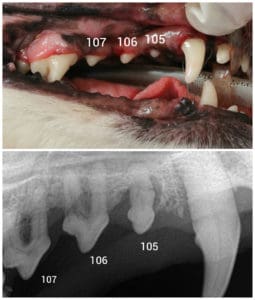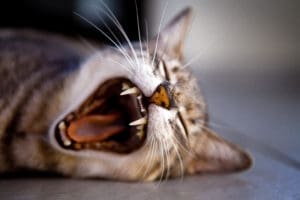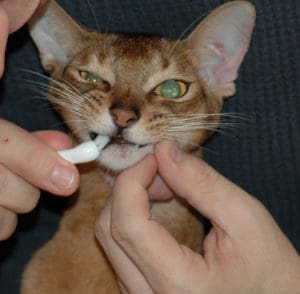February is National Pet Dental Health Month in order to bring awareness to the importance of annual oral health assessments and treatment (COHAT) to aid in keeping pets healthier overall. Many owners fear these dental cleanings due to age of the pet and anesthetic risks, but these are the animals that need it the most. Statistically, 80% of dogs and 70% of cats have some form of periodontal disease by age 3. Senior pets exhibit an increase in the extent of periodontal disease with increasing age, especially since many owners are not brushing their animal’s teeth on a regular basis. The bacteria in the mouth becomes plaque which can be brushed away. If brushing does not happen, that plaque eventually hardens into tartar and may require professional cleaning to remove.
General anesthesia is an important part of a thorough dental cleaning. The American Veterinary Dental College and the American Animal Hospital Association have guidelines against “anesthesia-free dentistry”. Anesthesia-free dentistry reduces the ability to make an accurate diagnosis, does not allow for adequate treatment, and increases stress and risks to the patient. Most dental disease occurs below the gumline, leading to resorption of the bone supporting the tooth. Loss of that bone leads to gum recession and other periodontal problems as well. Anesthesia-free cleanings do not allow for equipment to reach below the gums. With anesthesia there is less stress and pain for your pet, resulting in a more comprehensive dental cleaning.
Veterinary anesthesia has become much safer over the years. There are now safer anesthetic drugs, advanced monitoring machines, close monitoring under anesthesia by a qualified veterinary technician, as well as precautions such as pre-anesthetic bloodwork and intravenous (IV) fluids. If bloodwork identifies any underlying issues, those can be treated prior to the dental cleaning, allowing the patient to be in a more stable condition to handle the anesthetic event. All of these measures, combined, allow for a safer anesthetic event for the pet.

Another reason anesthesia is required is due to the ability to take full mouth dental radiographs. A sensor is placed in the pet’s mouth to get an accurate radiograph of the teeth and structures underneath the gumline. As stated previously, a majority of the disease occurs below the gums where it cannot be visualized. The information gained by interpretation of dental radiographs is an essential part of veterinary dentistry. It allows us to see the disease occurring around the tooth such as bone loss, infection, periodontal pockets, and other painful issues.
Periodontal disease is very painful and the animal may be showing you signs that it is time for the teeth to be checked. A change in your pet’s behavior may be an early sign of periodontal disease. If they are exhibiting any of the following, contact your vet to schedule an appointment sooner than just their annual check up:
- Bad breath
- Broken or loose teeth
- Extra teeth/retained baby teeth
- Discolored teeth
- Abnormal chewing, drooling, or dropping food from the mouth
- Reduced appetite
- Pain in or around mouth
- Bleeding from mouth
- Swelling on face or areas surrounding the mouth

Pets with regular dental care live an average of 2 years longer when compared with pets that don’t. There is a link between other diseases such as heart disease in pets with poor dental health. The inflammatory processes associated with the presence of dental disease and infection not only affect the oral cavity, but systemic organs as well. This is why it is important to perform dental cleanings regularly. The bacteria in the mouth advances into the bloodstream and travels to other organs, potentially impacting the function of the kidneys, liver, and heart.
Regularly brushing your pet’s teeth is the single most effective thing to do between professional cleanings. It takes time and patience, but if you can brush your pet’s teeth at least 3 times a week, that is still beneficial in keeping that plaque from building up again. Oral  health is an important aspect of quality of life for your pet. After dental cleanings, many owners notice a significant change in their pet’s behavior. They become playful and more active, acting much younger, and allowing quality of life to increase. Consistent dental cleanings can also reduce the chance of needing multiple extractions. The more your vet can clean your pet’s teeth and find infection early, the easier it is to save the teeth from needing to be extracted. It has been shown that dental cleanings help to restore bone and gingival tissue around teeth.
health is an important aspect of quality of life for your pet. After dental cleanings, many owners notice a significant change in their pet’s behavior. They become playful and more active, acting much younger, and allowing quality of life to increase. Consistent dental cleanings can also reduce the chance of needing multiple extractions. The more your vet can clean your pet’s teeth and find infection early, the easier it is to save the teeth from needing to be extracted. It has been shown that dental cleanings help to restore bone and gingival tissue around teeth.
In conclusion, senior pets need professional cleanings on a consistent basis to ensure a healthier, happier life for all.
Read another article here from the publisher of American Veterinarian about how to get started brushing your dog’s teeth.
Article written by: Lindsey G.